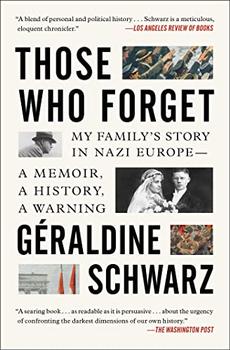Summary | Excerpt | Reading Guide | Reviews | Beyond the Book | Read-Alikes | Genres & Themes | Author Bio

My Family's Story in Nazi Europe – A Memoir, A History, A Warning
by Géraldine SchwarzThis article relates to Those Who Forget
 In Those Who Forget, author Géraldine Schwarz relates a visit her father paid to his parents' former home in Mannheim, Germany, looking for a specific "Stolperstein" installed outside the apartment.
In Those Who Forget, author Géraldine Schwarz relates a visit her father paid to his parents' former home in Mannheim, Germany, looking for a specific "Stolperstein" installed outside the apartment.
The word "Stolperstein" (plural "Stolpersteine") means "stumbling stone" or "stumbling block" in German. These small memorials to victims of the Nazi regime are concrete stones topped with brass plaques, each about 10 cm square, embedded outside the person's last-known residence. Each bears the words "here lived" followed by the individual's name, year of birth and their fate under Nazism (deportation, internment, etc.).
The Stolperstein project began to form in 1991, when artist Gunter Demnig created a paint line on the streets of Cologne that followed the route taken by approximately 1,000 Roma and Sinti residents from the Cologne-Bickendorf internment camp to the railway station at Cologne-Deutz (from whence they were transported to death camps in Poland). As the line began to fade, the artist decided to replace portions of it with engraved brass plaques. As he was installing these, Demnig came to realize that people who lived in the area did not understand that it was their neighbors who had been victimized, and he felt the need to expand his project.
In 1992, Demnig placed a stone in front of the Cologne town hall with an engraving based on Heinrich Himmler's "Auschwitz Decree" of December 16, 1942, which initiated the deportation of the Sinti and Roma. This stone, which he referred to as a "Stolperstein," was installed on the 50th anniversary of the decree — without legal permission. Although some objected to it, it remains in place today.
The Stolperstein idea continued to occupy Demnig's thoughts. In 1994, he exhibited 250 of the stones at St. Anthony's Church in Cologne, each commemorating a resident who had died at the hands of the Nazis. The Stolpersteine were well-received by the surviving relatives of the victims, and Demnig decided to expand the project across Europe. The first "stumbling blocks" in Berlin were installed two years later.
Demnig cites a verse from the Talmud in relation to the project: "A person is only forgotten when his or her name is forgotten." According to stolpersteine.eu, he no longer remembers how he came up with the term "Stolperstein," but often mentions a schoolchild who, when asked by a journalist if someone could actually trip on one, replied, "You don't trip on a Stolperstein, you stumble with your head and your heart."
Demnig has created a foundation to further the project, and currently has a staff of six to help him run it. The group can make about 440 Stolpersteine per month, each stamped by hand. Every installation is a solemn, unique event, never to be treated as routine. As of December 2019, 75,000 Stolpersteine had been laid in more than 1,200 cities in Europe and Russia, commemorating people belonging to many groups who were victims of the Holocaust. A Stolperstein can be made for any person who was persecuted under the Nazi regime — survivors as well as those who were murdered by the Nazis.
A Stolperstein costs €120 and can be requested by anyone. The organization asks that the person in question be fully researched, that documentation be provided and that an attempt be made to contact any living family members to gain permission. The requesting individual or group must also gain permission from city authorities for the installation, and not all cities will permit Stolpersteine. Some, like Munich, do not allow them because they are against the idea of people's names being stepped on. Whether or not permission is obtained for an installation can also depend on a city's current political climate.
Stolpersteine for the Feder family in Kolín, Czech Republic, by Francisco Peralta Torrejón (CC BY-SA 4.0)
Filed under Places, Cultures & Identities
![]() This "beyond the book article" relates to Those Who Forget. It originally ran in October 2020 and has been updated for the
September 2022 paperback edition.
Go to magazine.
This "beyond the book article" relates to Those Who Forget. It originally ran in October 2020 and has been updated for the
September 2022 paperback edition.
Go to magazine.
Your guide toexceptional books
BookBrowse seeks out and recommends the best in contemporary fiction and nonfiction—books that not only engage and entertain but also deepen our understanding of ourselves and the world around us.